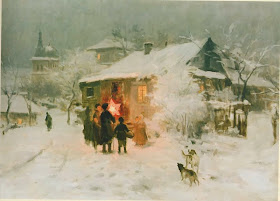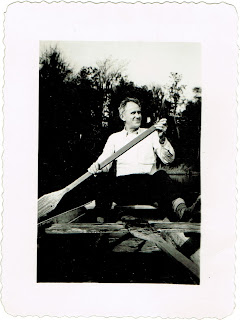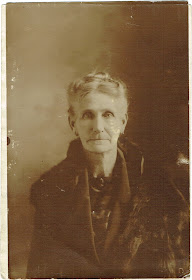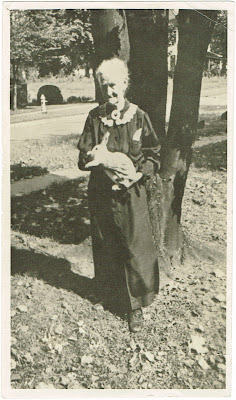Don’t you just love it when, flipping through old family
photographs, a sweet face stares back at you and captures your heart?
For the last several days, I’ve been stymied with the rush
of all the family pictures I’ve suddenly inherited. Blame it on holiday
obligations or a lingering cold that befuddles my mind, but I’m stuck under an
avalanche of glossies. I have no clue where to begin to sort this collection
into anything that would make sense to the proverbial innocent bystander.
I’d like to set out to document my findings in a logical
progression—something along the lines of branches in the family tree—but I can’t
even find enough room to claim as working space to sort and label the mess.
So I keep flipping through pockets of pictures tucked away
in envelopes, old wallets—everything but
labeled albums—wondering where to begin.
And then this cherubic face looks up at me and nearly begs, “Start
here.”
So, as usual, I find myself, once again, starting from the
middle.
Here, in the middle of my aunt’s collection of family
keepsakes, is a photo of a young child. My guess is that the picture was
snapped by her mother, who penned on the reverse, “I love her in this picture
made in the back lawn.”
I’m presuming the rest of the story about the journey this
picture took from there to here involved mailing it to the photographer’s own
mother. Thankfully, that grandmother had enough sense to label the picture with
the grandchild’s name, for in a different hand and color of ink, the words were
inserted, “
Sarah Martha Moore.”
I wonder if the rest of the journey for this picture
involved this grandmother’s son inheriting the woman’s personal effects,
including this photograph. He, in turn, left it up to his wife to organize and
dispose of the collection as she saw fit. His wife, apparently, chose to keep
the photo, but upon her passing, the whole collection became the property of
her daughter.
That daughter would be my aunt.
Isn’t your head spinning? That’s why genealogists employ
databases to keep this stuff straight.
Thinking about Sarah Martha always makes me sad. Not because
of Sarah Martha, herself—I never met this cousin-once-removed. But I’ve heard
her name so many times. She was my mother’s favorite cousin on her paternal
side.
Back in the early 1990s, when I rebooted my pursuit of
family history, I had been discussing all the now-available resources I had
found online in my customary phone calls back east to my mother. My mom had
perked up at the notion that people with whom she had lost contact might still
be accessible through online searches.
“Can you see whatever happened to Sarah Martha?” she asked
me. Certain that I could, I promised her I would make that a priority.
Sadly, not more than a few months later, I ran across an
item indicating that Sarah Martha—or at least someone who, strangely, had
managed to have the exact same name—had passed away.
All the data was right. By this time I had inherited my
grandmother’s little address book, showing “Mr. and Mrs. C. J. McKinnon”—Sarah Martha’s
married name, according to that prim and proper Southern style of address—living
in a Baltimore suburb right by the place where this Sarah Martha had died.
Any genealogist, however, knows it’s not really over until
the fat lady sends that confirming copy of the death certificate, so I didn’t
want to say anything to my mom until I could determine that I had the right
person. Sending for a copy of that cert, however, is not an easy thing in the
state of Maryland
unless you are the direct descendant of the deceased. I, of course, was not.
I thought I’d try a different route: obituaries. Even with
the help of the friendly librarian at the city’s main library, none could be
located.
Cemetery? I was clueless where to look. I gave it my best
try, but no results in the Baltimore
area.
I even tried looking up others with the same surname in the
suburb, writing those “please-excuse-me-for-the-intrusion” letters in hopes
that one would find its way to the right family. After all, those would
possibly be second cousins I’d be connecting with, if any answered. No
response.
The more daunting approach was to guess what those
prim-and-proper Southern-style initials might represent for Sarah Martha’s
husband. Perhaps he had an obituary published which could lead me to any
descendants. I remember sitting down at the computer one long evening and
starting a search, trying for possibilities every man’s name beginning with the
letter “C.”
I gave up long before the middle of the alphabet. And that’s
a good thing, as I realized when I later found the likely candidate for those
initials to be “Cyril John.”
It’s been nearly twenty years since I had to tell my mom
that, best I could tell, she would no longer be able to enjoy a later-life
reunion with her beloved cousin. In those many years, I’ve thought, wistfully,
about Sarah Martha many times. What an interesting life she must have led,
being the only daughter of a teacher who married an older railroad executive
with the caveat that the deal that began with “I do” included a life lived in
exotic locations in far-away Central America. What a wonderful wrap to such a life's story to find a way to reunite two cousins.
I can find, thanks to documents available at
Ancestry.com, records of Sarah Martha's earlier travels back to the States to visit family or to return
to the boarding school she attended in her later childhood. Oh, how I wished I
could have made that personal connection, though. Sometimes, it’s nice to use
those genealogical research skills to find those of our family we are seeking
among the living.































